Egon Schiele (1890-1918) was an Austrian painter known for his raw, expressive style that marked him as one of the most influential artists of the early 20th century. Schiele’s work is often associated with the Expressionist movement and is characterised by provocative, emotionally intense subjects. He is remembered for his striking self-portraits, nude studies, and depictions of figures that challenge traditional representations of the human body and psyche. Here’s a look at his life and major works:
Early Life and Background
Schiele was born on June 12, 1890, in Tulln, Austria. He was the third child of Adolf Schiele, a railway stationmaster, and Marie Soukup. Schiele showed a keen interest in art from a young age, and by his teens, he was producing art with skill beyond his years. The early death of his father in 1905 had a profound impact on Schiele, leading him to a more introspective and often dark approach to art.
At age 16, Schiele enrolled at the Vienna Academy of Fine Arts. His instructors were conservative, and Schiele, feeling creatively stifled, left after three years. This break was crucial in allowing him to experiment with his own unique, highly stylized form.
Influences and Relationship with Gustav Klimt
One of Schiele’s greatest influences was Gustav Klimt, a leading figure in the Vienna Secession and a celebrated artist known for his decorative, sensual paintings. Klimt mentored Schiele, introducing him to his circle of supporters and helping him gain access to wealthy patrons. This mentorship also exposed Schiele to new ideas and techniques, which he quickly integrated into his evolving style.
Klimt's influence is visible in Schiele’s early works, where decorative elements and bold lines are reminiscent of Klimt's approach. However, Schiele soon took a more confrontational approach, focusing on emotional and psychological exploration rather than beauty.
Artistic Style and Themes
Schiele developed a unique, raw style that often involved the use of angular, distorted figures. His works frequently featured nude figures and self-portraits, many of which were considered shocking due to their erotic and sometimes unsettling nature. Schiele’s line work was jagged and expressive, and he used stark, contrasting colors to enhance the intensity of his subjects’ emotions.
One of his most compelling themes was the human body, which he explored through provocative, contorted poses and often gaunt, exaggerated forms. Schiele’s work questioned traditional notions of beauty, instead embracing the flawed and vulnerable aspects of humanity.
Major Works
Self-Portraits
Schiele is perhaps best known for his numerous self-portraits, which are unlike traditional portraits of the time. In Self-Portrait with Physalis (1912), Schiele uses sharp lines and a distinct color palette to highlight his facial expressions. His self-portraits often depict his thin, almost skeletal frame, revealing an intimate, sometimes tortured view of himself.Seated Male Nude (Self-Portrait) (1910)
One of Schiele’s most powerful early works, this self-portrait is raw and vulnerable, with his body positioned in a twisted, uncomfortable pose. It reflects Schiele’s interest in exploring the uncomfortable truths of human existence.Death and the Maiden (1915)
This painting reflects the relationship between Schiele and his former lover Wally Neuzil. The figures, entangled in an intense embrace, symbolize both love and loss, echoing Schiele's preoccupation with themes of mortality.Portrait of Wally (1912)
Wally Neuzil, Schiele’s lover and model, appears frequently in his works. This portrait captures her with a melancholic expression, emphasizing the emotional intimacy between the artist and his subject.Cardinal and Nun (Caress) (1912)
Inspired by Klimt’s The Kiss, this painting depicts a man and a woman locked in an embrace. However, Schiele’s version is darker, exploring themes of forbidden love and societal constraints.The Family (1918)
Created shortly before his death, The Family is a haunting work that shows Schiele, his wife Edith, and their unborn child. The somber tones and expressions in the painting reflect the artist's sense of looming tragedy, as he was soon to lose both his wife and his life to the 1918 influenza pandemic.Nude Girl (1910)
This painting, one of many nude studies, reflects Schiele’s interest in capturing the body’s natural, unidealized form. His frank portrayal of nudity, especially in young subjects, was highly controversial at the time.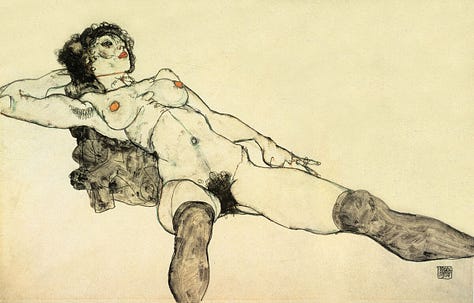


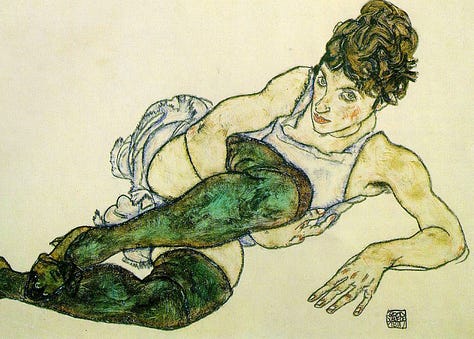

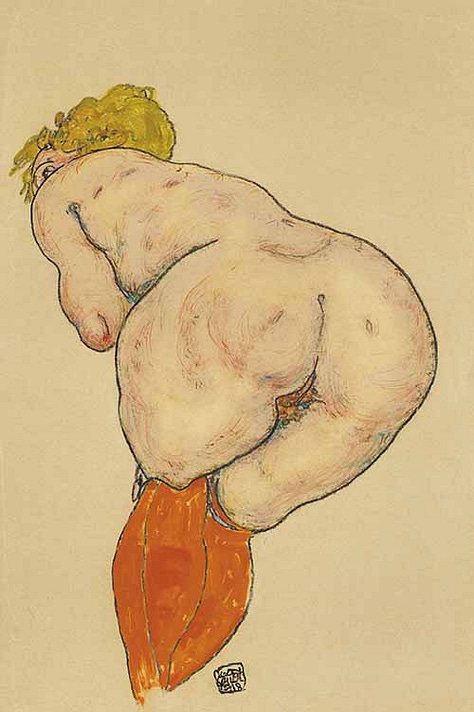
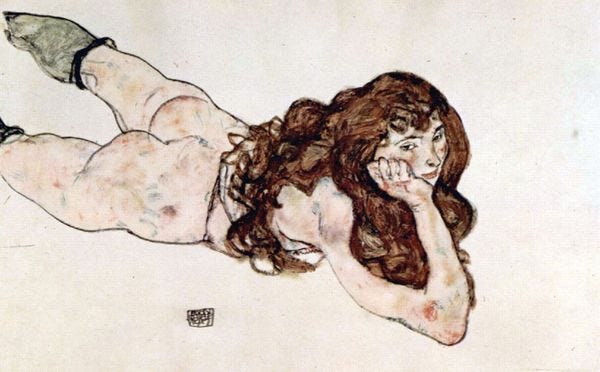
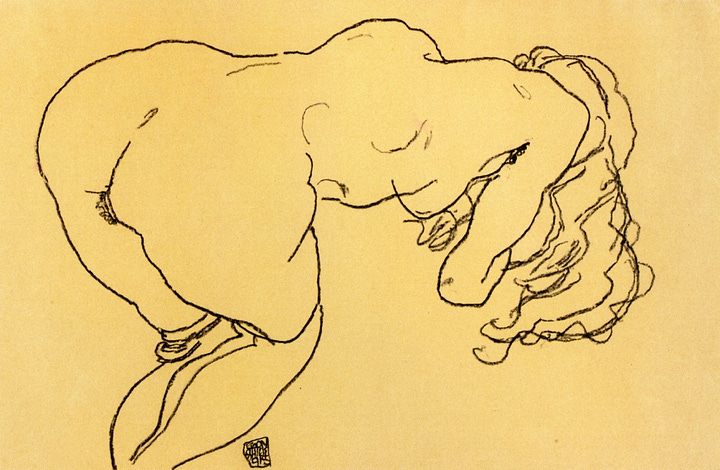
Controversy and Legal Issues
Schiele’s career was not without scandal. In 1912, he was arrested on charges of "immorality" due to his nude drawings, especially those of young models. His studio was raided, and several of his works were confiscated. Though he was eventually acquitted of serious charges, he served a short prison sentence for "public immorality." This incident only heightened his rebellious image and inspired a series of introspective works created while in jail.
Later Life and Legacy
In 1915, Schiele married Edith Harms, which led to a distancing from Wally, his previous muse. Edith’s influence seemed to soften some of his work, though he maintained his intense focus on the human figure and existential themes. The same year, Schiele began to gain significant recognition, receiving invitations to exhibit across Europe, which marked the height of his career.
Tragically, Schiele’s life was cut short by the Spanish influenza pandemic in 1918, which also claimed his wife, Edith, who was six months pregnant. Schiele died on October 31, 1918, at the age of 28, but his brief career left a profound impact on modern art.


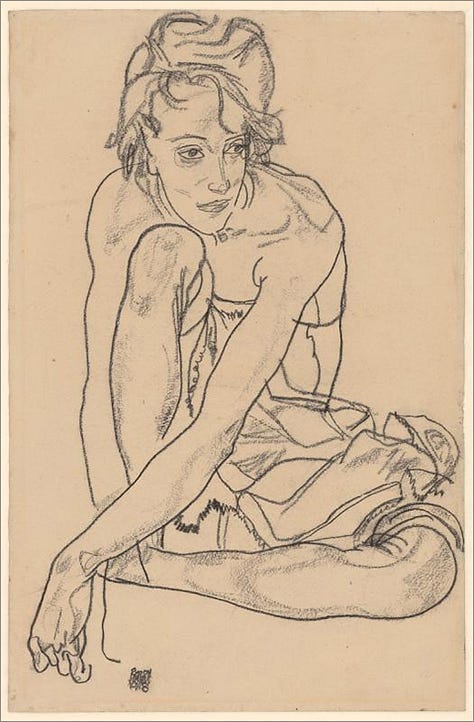

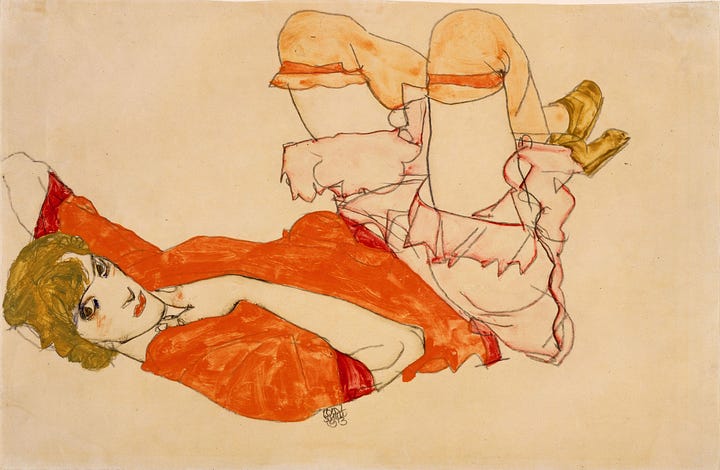
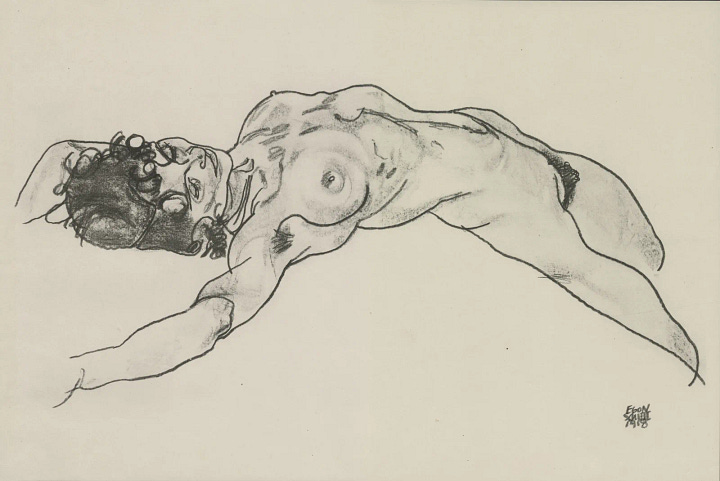
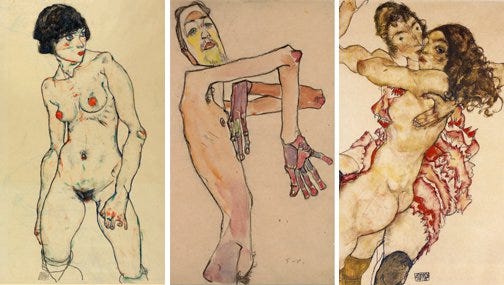
Legacy and Influence
Despite his short life, Schiele's work had a lasting impact on the development of Expressionism and influenced countless artists, particularly in the use of bold lines, raw emotion, and psychological depth. Today, he is celebrated as a pioneer who challenged conventions and exposed the vulnerable side of humanity.
Schiele's art continues to captivate audiences, with his works housed in major museums and collections worldwide, including the Leopold Museum in Vienna, which holds the largest collection of his work. His fearless exploration of the human form and psyche cements his status as a major figure in modern art history.
You can book us for your drawing class or attend our weekly sketching practice by visiting us at our website.
You can support us in these ways too!
1. Subscribing monthly via Substack
2. Making a one-off contribution via BuyMeACoffee
Your support is what allows these articles to keep being created and is enormously appreciated. Thank you.




